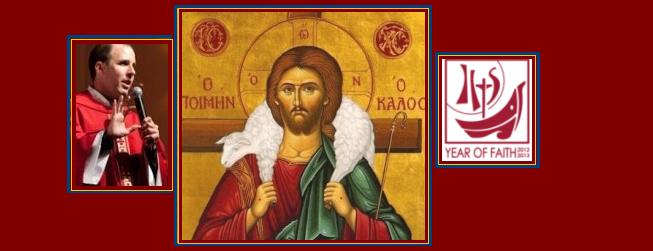…the Scriptures are not a systematic presentation of the faith. Nevertheless, the doctrines of the faith are contained in Sacred Scripture, so the Lectionary readings can be the basis for preaching about doctrine.
Pope Benedict XVI has called us to live began on October 11, and will last until November 24, 2013. In Porta Fidei, his apostolic letter announcing the Year of Faith, the Holy Father asks each of us to “rediscover the content of the faith that is professed, celebrated, lived and prayed, and to reflect on the act of faith” (§ 9). Our Catholic faith has an intellectual content to be known so it can be embraced, pondered, lived, and taught.
The homily is the best opportunity pastors have to help the laity deepen their faith and live it. Sunday Mass is the time each week when all the faithful who practice their faith are present.
The homily might not seem the natural place for a doctrinal catechesis. The General Instruction of the Roman Missal tells us the homily should be :
“an exposition of some aspect of the readings from Sacred Scripture or of another text from the Ordinary or from the Proper of the Mass of the day” to nurture the Christian life, taking “into account both the mystery being celebrated and the particular needs of the listeners” (§ 65).
While the post-Vatican-II Lectionary for Mass is a rich presentation of the Sacred Scriptures following a systematic plan, the Scriptures are not, of course, a systematic presentation of the faith. Nevertheless, the doctrines of the faith are contained in Sacred Scripture, so the Lectionary readings can be the basis for preaching about doctrine. Certainly, one of the critical “particular needs of the listeners” is a sound doctrinal catechesis. Hence, we have the Year of Faith.
Beginning with the First Sunday of Advent, this blog is offering, for every Sunday of the Year of Faith, an outline which homilists can use to prepare doctrinally-focused homilies which grow out of the Lectionary readings. The outlines will follow a three-part template: central idea, doctrine, and practical application.
• First, a central idea, which the group of readings contains, will be articulated. In this way, the homilist can illuminate the overall salvific meaning of the Lectionary readings.
• Second, one doctrine from the Deposit of Faith or Catholic morals which the readings contain will be identified. The outline will help the homilist define, explain, and illustrate this doctrine.
• Third, practical ways that the laity can apply this doctrine to their lives will be offered. This third step helps accomplish the Church’s desire that the homilist “nurture the Christian life” of the lay faithful. It helps fulfill the goal of the Year of Faith that the faith be lived.
This template and the content the weekly posts will supply will meet the requirement that the homily nourish the faithful by explaining the Word of God to them. It also answers the call of Pope Benedict to teach doctrine during the Year of Faith. Finally, it fulfills an urgent particular need of the laity: how practically to apply the faith in our ordinary lives.
No homily can fully expound all the riches contained in any set of Lectionary readings, but every homily can explain some of them. In the Year of Faith, homilists can get into the habit of drawing out the doctrinal riches, which the Sacred Scriptures contain. In addition, pastors can connect these doctrines to the ordinary lives of the laity. Each week, the homilist can offer the faithful a new facet of the intellectual content of our faith so the faithful can embrace it, ponder it, live it, and even teach it to others as part of the New Evangelization.
To check out the these additional weekly insights in writing homilies for Sundays and Holy Days, presented by Kevin Aldrich, go to: http://www.doctrinalhomilyoutlines.com

Your project will be beneficial to me — and many others also. Thank you very much for this undertaking. I look forward to reading this column every week. I hope there will be references to particular paragraphs in the Catechism. Best wishes for success; good prayers for your success in this enterprise. Albert Baxley
Just one suggestion from a lay man to another: where you write:
“Third, practical ways that the laity can apply this doctrine to their lives will be offered. This third step helps accomplish the Church’s desire that the homilist “nurture the Christian life” of the lay faithful.”
I would suggest instead:
“Third, practical ways that the members of the Church can apply this doctrine to their lives will be offered. This third step helps accomplish the Church’s desire that the homilist “nurture the Christian life” of the faithful.”
The need to grow in holiness and faithfulness is of course not limited to the laity, and it can be helpful when this truth is recognized (in all sincerity) from the pulpit.
Thank you.
Thank you Mr. Aldrich fr your well balanced article on homilys. noticed you write screenplays. I have been searching for a writer to help me to write a screenplay to :” Parsh Priest ” the biographyy of Venerable Father Michael McGivney fonder of the Knights of Columbus of which I am a member. Thank you for your consideration MartinDrew Dallas, Tx. 75214